Recently in Facilities Services Category
The University of Chicago has made a commitment to become a more bicycle-friendly campus. As a part of this commitment, and in an effort to support the City of Chicago’s aim to become a leading city for cyclists, Facilities Services has established an updated Abandoned Bike Policy (PDF).

Any abandoned or improperly locked bike is subject to removal by Facilities Services. The impounded bicycle will be stored at the Young Building, 5555 S. Ellis Avenue, for 10 business days. After 10 business days, the bicycle will be donated to charity. This policy is intended to help maintain the safety and beauty of the University of Chicago’s campus, to manage the capacity of existing bike racks by removing abandoned bikes, and to ensure accessible walks and ramps are maintained.
While Facilities Services regularly removes improperly locked or abandoned bikes throughout the year, two formal campus bike sweeps take place annually: one at the conclusion of Fall Quarter and another prior to Spring Convocation. Over the past year, the University has donated over 70 bikes to recycles partner, Blackstone Bicycle Works.
To report abandoned or improperly locked bikes, or to request additional bike racks, please telephone the FS Service Center at 773-834-1414.
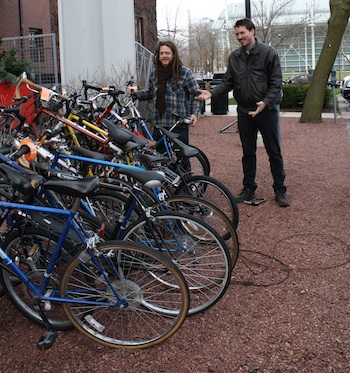 Aaron Swanton and Chris Willard from Blackstone Bicycle Works were surprised by the number of bikes ready for donation this past December.
Aaron Swanton and Chris Willard from Blackstone Bicycle Works were surprised by the number of bikes ready for donation this past December.
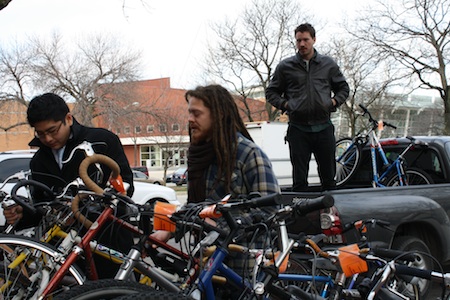 Kevin Ahn, Facilities Services’ Client Services Manager, assists Blackstone with the most recent bike donation.
Kevin Ahn, Facilities Services’ Client Services Manager, assists Blackstone with the most recent bike donation.

A new shipment recently arrived for Facilities Services: three 100% electric vehicles to be added to their current fleet. These are the first Neighborhood Electric Vehicles (NEVs) to come to UChicago’s campus. The cars, pictured above, will be replacing two 100% gasoline-powered trucks and a van.
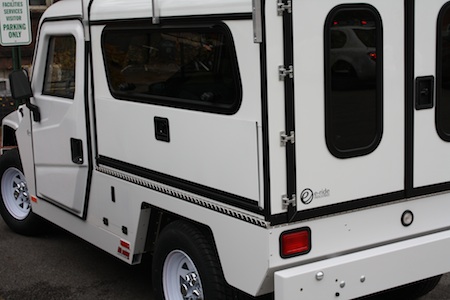
The NEVs are made in Minnesota by a company called e-ride. Using American Made parts and labor, they sell two models of vehicles the can be found on many other campuses, as well as in other settings. University of Wisconsin maintains about 40 of these cars in their fleet and just last April, e-ride vehicles made their debut in Antarctica. On our campus, the vehicles will most likely serve one of Facilities’ shops, such as the carpentry or painting shops. In the coming weeks, these shops will be piloting the NEVs, which will inform Facilities’ needs for the next shipment of electric vehicles. One limitation, about which we’re already aware, is that each car can only carry up to 4,200 pounds. Thus, they will be used primarily to transport people and smaller equipment in the shops.

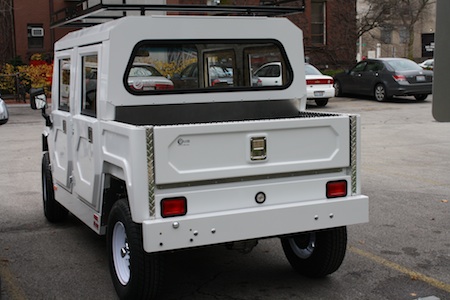
As they run on only electric charge, the NEVs are rather simple in design. The windows must be hand churned, there is no radio, and the only fluid under the hood is a small container of brake fluid. They charge for approximately eight hours (overnight) and should last about 20-35 miles per charge, depending on conditions and what utilities are used. When accelerating, the NEVs have a good amount of pick up but top off at around 25 mph—perfect for on-campus driving.
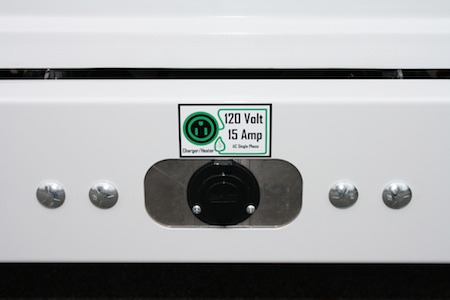
The addition of NEVs to the campus fleet is one of many steps the University is taking to make the campus more sustainable. According to Kevin Austin, the Director of Building Services for Facilities Services, “end users have to invest in and commit to a technology in order for it to survive and evolve over time.” As the University makes this initial commitment to electric transportation, Facilities hopes to continue to invest in similar green technologies.
Streamlining printing processes and reducing excess printing were identified by Facilities Services’ SAGE Ambassadors as priority goals for greening the Young Building, and so, inspired by March Madness, the Print Sprint Tournament was born! The aim of this friendly competition was to reduce the amount of paper used in the building by reducing copies and printouts. While it was unrealistic to expect everyone to forego these practices completely, the Print Sprint helped increase awareness of participants’ actions.
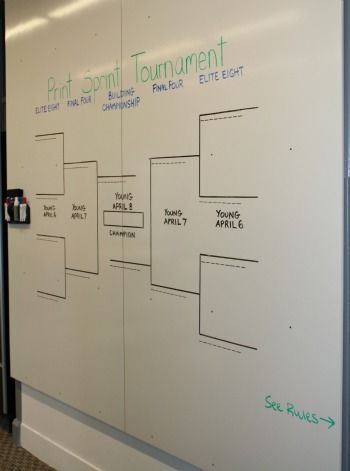

Young Building occupants enthusiastically partook in the Print Sprint Tournament this past spring. Participants were divided into eight randomly selected teams and collaborated to come up with creative team names, such as “The Team Formerly Known as Prints.” There was much talk in the hallways of Young and over email—mostly about strategies for reducing printouts and copies.
Each team competed against their daily pairings in a single-elimination style tournament. The tournament lasted three days and only the winners of each day’s match up advanced to the next round. The daily winners were the teams that produced fewer printouts and copies than their opponent. Participants were responsible for keeping track of their own paper use and reporting daily tallies on the score board.
Participants worked to overcome obstacles, such as meetings outside of the Young building. Kimberlyn Davis limited her printing, despite meeting with outside vendors. “At first, everyone seemed somewhat surprised when I asked them to share an agenda,” she said, “but once I explained the Print Sprint to them, their eyes lit up and they expressed interest in bringing the idea back to their office.” Teams worked together to remind one another of their goal to reduce printouts and copies. For Arleta Porter, the Print Sprint built awareness. “It was the first time I consciously thought about double-sided printing,” she said, “and now I plan to double-side print whenever possible.”
The winning team, TANSTAAFL (There Ain’t No Such Thing As A Free Lunch, in U of C fashion), enjoyed a catered lunch from Fig Catering, as well as bragging rights.
If interested in coordinating a Print Sprint in your office or department, contact Katie.
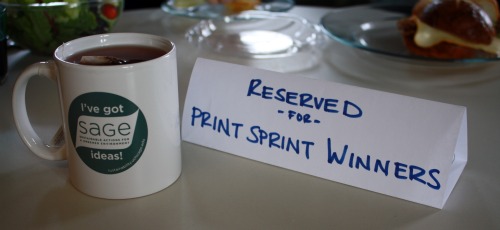
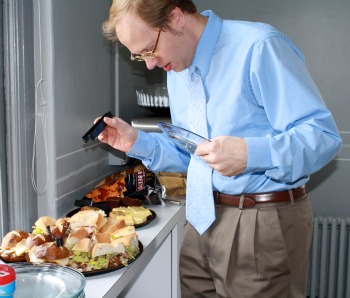 Jim Cook, member of the winning TANSTAAFL team, decides which delicious treat to try.
Jim Cook, member of the winning TANSTAAFL team, decides which delicious treat to try.
 Kimberlyn Davis and Mark Carlson celebrate their victory.
Kimberlyn Davis and Mark Carlson celebrate their victory.
I’m on Facebook, my boss is on LinkedIn, my friend is on Twitter, and Searle Chemistry Laboratory is on Dashboard! Yes, it is true; the social networking craze has officially spread to buildings at the University of Chicago. Searle Laboratory is the first building installed with a Lucid Building Dashboard© energy monitoring system. And while you can in fact find a few juicy pictures of Searle on its Dashboard profile, the most interesting and important part of the Dashboard is its interactive display of real-time energy consumption.
At any time during the day or night—or if you just need a quick study break—you can go on Searle’s Dashboard profile to view the electricity, natural gas, and chilled water consumption of the recently renovated LEED Gold building. It is especially fun to stalk these areas of Searle, as they collectively comprise over 75% of the building’s energy use. For added media sensation, you can examine Searle’s energy data across multiple time scales and according to different unit equivalents, like gallons of gasoline, tons of carbon, or plain old cash money.
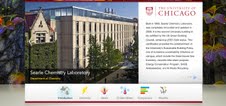
The Searle Dashboard is part of a wider University initiative to install energy monitoring systems in all campus buildings that will help track greenhouse gas emissions reductions. The University is currently considering three different systems and anticipates eventual campus-wide installation.
Searle’s Dashboard can be viewed the old fashioned way in the lobby of the building, as well as from wherever you and your laptop, smart phone, or tablet happen to be. So go friend Searle today!
In October of 2010 the Young Memorial Building, home to the University of Chicago’s Facilities Services, was reopened after undergoing an extensive renovation project. The seven-month long project was intended to extend the life of the structure and make the building a healthier, more pleasant, and more sustainable place to work. To learn more about the project, find the full case study of the project on our website. Check out the pictures below to see what sustainability can look like!

The renovated foyer of the Young Building boasts vibrant colors and custom, sustainable flooring. The well-lit space ensures that the Young Building is welcoming to both Facilities Services staff and guests. The foyer also showcases current and future Facilities Services projects. Shown in this picture is the Logan Arts Center, a new, sustainably-designed center for the fine arts at the University of Chicago.
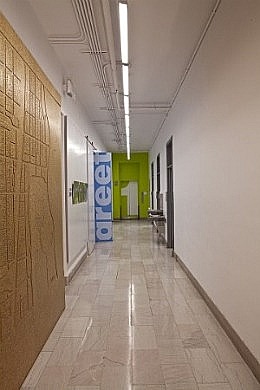
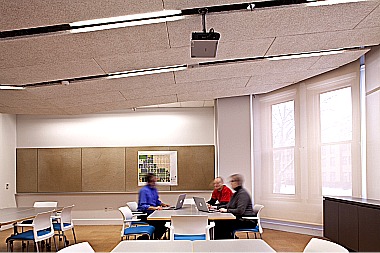
Two of the most prominent sustainability features at Young—and favorites of many occupants—are the giant campus map made out of wheat board and the cork floor in the conference room/yoga studio. Both features represent innovative resource use that is directly tied to the context of the building’s occupants: the map reflecting the work of the Facilities Services department throughout the entire campus and the cork floor providing a pleasing surface for the many employees who practice yoga every Friday.
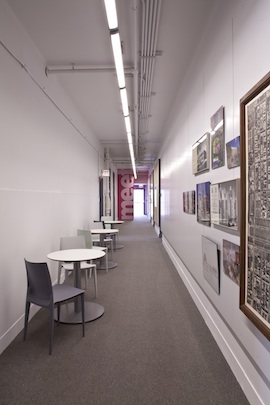
The second floor corridor represents a number of sustainable design features. Many of the lights fixtures and furniture were reclaimed from other buildings on campus while much of the new furniture included demonstration sets that were donated or sold at a discount by vendors who would have otherwise sent the furniture to a landfill.

The kitchen on the 3rd floor is stocked with dishes, glasses, water pitchers, and flatware to decrease the amount of paper and plastic disposables used in the building.

Large windows, open spaces, and the natural light they provide make the fourth floor a place for office collaboration.
Special thanks to David Woodhouse Architects for the photos.
Under the direction of IT Services, Facilities Services IT management team has been steadily switching its server platform from physical servers to virtual servers, also known as virtual machines (VMs).
So what is a VM and why is it more sustainable? A VM is a server that exists virtually and is therefore not tied to any one piece of hardware. If a simple example is helpful, think of Gmail and the way it works; the entire application is virtualized, none of your emails exist anywhere on your computer’s hard drive. A VM platform is a more sustainable way to manage computing tasks for at least two reasons, neither of which are normally possible with physical servers.
A VM platform allows for the full (usually about 85-90%) computing power of the underlying hardware to be utilized; this reduces electricity and material consumption.
When a VM platform is being employed, server operations can be fluidly reassigned across underlying hardware in a matter of minutes, making VMs much more adaptable to the changing needs of their clients. This greater adaptability reduces time and labor and thereby increases the amount of computing that can be done with fewer resources.
Because of these efficiency gains, a standard VM is both much smaller and uses far less energy than its physical server counterpart. A typical VM at the U of C uses only 13 watts of power on average, while a physical server uses 281 watts, making VMs much more sustainable.
Recognizing the increased sustainability of VMs, Facilities Services IT management team is going virtual. Facilities Services currently operates 42 servers, 27 of which are already virtualized. By the end of 2011, 32 of Facilities Services’ servers will be virtualized, with the remaining physical servers replaced by virtual servers upon their decommissioning. Facilities Services plans to eventually have its entire server platform virtualized.
Be sure to look for a forthcoming, comprehensive case studying outlining the other exciting ways in which IT Services at the U of C is using technology to become more sustainable.
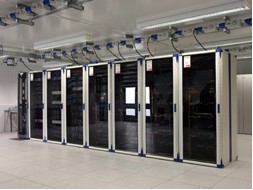
Special thanks to IT Services personnel and SAGE Ambassador, Chuck Korponya, for helping to produce this post.
Photo courtesy of: http://mjrinfotech.com/; accessed 8 March 2011
The newly instituted Policy on Bottled Water eliminates plastic water bottles in Facilities Services buildings, meetings, and events. Instead, Facilities Services is providing reusable pitchers, cups, and trays for serving water at meetings and events in the Young Building, supplying each staff member with a reusable aluminum water bottle from the Office of Sustainability, and promoting the continued installation of water bottle filling stations in all Facilities staff locations.
"Facilities Services strives to be a campus leader in sustainability and this policy is just one example of our efforts to use resources -- both natural and monetary -- most efficiently," says Erin Wieand, Executive Director of Management Services, Facilities Services.
 So what's the beef with plastic water bottles? They rely heavily on fossil fuels in their production, packaging, and transportation, which result in massive waste and energy use. While plastic water bottles are indeed recyclable, the vast majority does not get recycled. In fact, plastic water bottles are the fastest growing form of municipal solid waste in the U.S., resulting in more than 4 billion pounds of PET plastic bottles ending up in landfills or as roadside litter! Moreover, the federal government does not mandate that bottled water be any safer than tap water and about half of all bottled water is really tap water in disguise, as many bottled water manufacturers simply source it from municipal water supplies. For more facts and information on bottled water, visit Environmental Working Group.
So what's the beef with plastic water bottles? They rely heavily on fossil fuels in their production, packaging, and transportation, which result in massive waste and energy use. While plastic water bottles are indeed recyclable, the vast majority does not get recycled. In fact, plastic water bottles are the fastest growing form of municipal solid waste in the U.S., resulting in more than 4 billion pounds of PET plastic bottles ending up in landfills or as roadside litter! Moreover, the federal government does not mandate that bottled water be any safer than tap water and about half of all bottled water is really tap water in disguise, as many bottled water manufacturers simply source it from municipal water supplies. For more facts and information on bottled water, visit Environmental Working Group. 